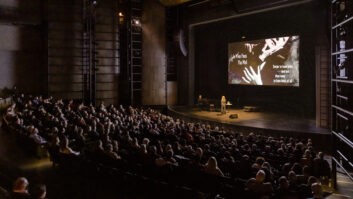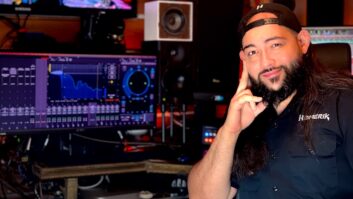If the name Alien Soundscapes Incorporated conjures up some nightmare vision out cf The X-Files or the paintings of H.R. Geiger, rest assured the intent is entirely benign. “It comes from my love of astronomy and science fiction,” says owner Chris Greene of his Chicago multimedia, mastering and recording facility. “I feel as though the name implies creativity and almost a higher calling in terms of both expression and fidelity.”
For Greene, the building of ASI fulfilled a long-held dream. The son of a noted opera singer (tenor William Greene, who died in mid-September) and a mother who is a poet and a lawyer, Greene began studying the violin at age 7. Through his mid-teens, he seemed to be on track to become a solo violinist of some note. He studied harmony and orchestration for years and played in various Chicago-area orchestras. But he also became fascinated by recording studios: Through one of his teachers, the famed early Moog synthesizer programmer Hans Wurman, Greene spent a considerable amount of time in a local studio, DB on Wells, where Wurman had “a wall-sized Moog with lots of cables, blinking lights and fantastic sounds,” Greene remembers. “Electronics was very appealing to me, and this was my first exposure to the potential of a recording studio.”
By the time he was 17, Greene had veered away from his classical studies. “It seemed too limiting,” he says now, “though I still adore classical music and quite a bit of opera.” He tried unsuccessfully to get a job as an assistant in a recording studio; when that failed, he became a club DJ, working at a number of Chicago’s hottest clubs. Eventually, he says, “I decided I wanted to make records instead of spinning them,” and with an eye toward building his own studio, he took a series of jobs to earn enough money to buy recording equipment. Along the way, he became something of an expert in computers, and for a while, he worked for retailers debugging computers and did beta testing and troubleshooting for a number of manufacturers, “including most of Digidesign’s third-party manufacturers-Emagic, Magma, Opcode…”
Greene started his system by purchasing Digi’s Session 8 when it was released. “From there, I just kept expanding to the point where we’re fortunate to have one of the most expanded systems in the world,” he says. “I’ve had this vision of what a digital audio workstation could be, and it has always included Apple, Digidesign, three-plus monitors and an incredible amount of desktop space. So I’ve been working with that goal in mind.” Originally, ASI was in the basement of Greene’s home, but after he and a close friend, Alex Gustafson, spent a year producing an enhanced CD-ROM trumpeting the potential of his facility, he managed to get a bank loan to build ASI’s current site overlooking the Chicago River. He then brought in architect James Collins and acoustician Doug Jones to work up plans for the studio.
Today, the main room at ASI offers a blend of up-to-the-minute digital and classic analog technology. At the heart of the system is Digidesign’s Pro Tools (16 cards strong) and Pro Control, perfect for the mastering and multimedia work that is the studio’s specialty. Surround monitoring is done on Genelecs-three 1031s, two 1030s and a 1094 sub-via Kind of Loud’s TDM plug-ins. Among the studio’s large complement of analog outboard gear are pieces from Manley, Avalon, Demeter, Studio Technologies, Aphex and Rane. Greene also owns a number of vintage instruments and guitar amplifiers.
“Currently our business is in two halves-we have an audio business and a separate media division,” Greene says. “We do absolutely first-class media design, which includes 3-D animation, Web sites, CD-ROM/DVD authoring, whatever anyone needs. Our current project is a media makeover for dBSound [the concert sound company], which includes a low bandwidth Flash/static hybrid Web site and an interactive CD-ROM with several very cool 3-D movies of stadium speaker arrays we use to explain their unique techniques. Our next project is to revamp completely in Flash our own aliensound.com Web site. We have a staff of artists who I believe are the best in the world. And because we’re pro audio people, the audio side has always been extemely important to us. The audio side is primarily a mastering and post-production facility. Mastering is the studio’s specialty. And I write and produce several projects a year.”






